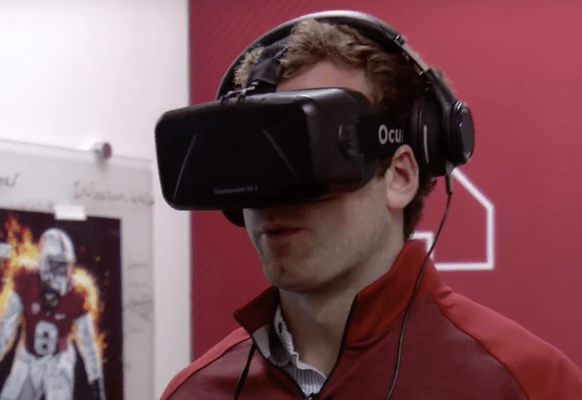Football is a downright violent sport. If players aren’t injured in the games themselves, there’s a chance that they could be hurt in practice. It happens all the time.
While there’s no substitute for actual football practice, there is a technology enjoying rapid growth in the NFL and it involves taking contact-free virtual reps: virtual reality training.
STRIVR Labs CEO and founder, Derek Belch, says his company alone has seven NFL franchises that have invested in his immersive, 360-degree virtual reality training software and could have a few more by the time the 2016 season kicks off this September. So, essentially a majority of the league will be using VR to gain an edge soon enough.
That’s an incredibly fast adoption rate. The Dallas Cowboys became the first team in the NFL to buy into STRIVR’s VR training last June. Six more franchises reached an agreement with the Silicon Valley-based company since then.
Belch is also expecting an additional few franchises to sign up over the next two months. While Belch said he’s not at liberty to mention all of STRIVR’s NFL clients, the Cowboys, Arizona Cardinals, San Francisco 49ers, Minnesota Vikings and New York Jets have been publicly announced before.
“Truthfully, I’m surprised it hasn’t grown faster based on some of the results we have seen,” Belch said. “There are a lot of reasons why football is a good fit [for VR].”
So, how does it work? Well, once a team calls on STRIVR with interest, Belch shows them a generic demo of the software, hooking them up to an Oculus Rift or any other VR headset. From there, if an agreement is made, the company captures 50 or so plays that the team runs during practice.
Although Belch wouldn’t plunge into the company’s secret sauce nor financial terms with teams, he says STRIVR uses everything from GoPros to high-end Blackmagic cameras to capture footage, before using a combination of custom-built computer and camera solutions, and custom software which automatically fits video together at the highest quality… and swiftly.
Belch says the turnaround time for STRIVR to deliver a finished product to teams after initially recording them ranges from 90 minutes to two hours, down from the four to seven hours it took the company last season. Belch credits improved software for that.
Once players throw on their VR headsets, they’re immersed in a 360-degree virtual environment, allowing them to read and react to plays like they do in practice, except this kind of practice doesn’t involve pads nor contact — something ideal for players working their way back from injuries.
“I don’t think it’s going to prevent injuries,” Belch said of VR in the NFL. “There’s nothing better than actual, physical practice on the field. But I will say because we saw it last year and we’ll see it again, I’m injured and can’t practice and shouldn’t practice on a Thursday or Friday and so instead of practice, I go into VR. I don’t think we’re going to prevent injuries, but I think we may be able to help players to keep their bodies fresh when they are injured and prevent further injuries.”
Belch estimates that a third of NCAA Division I football programs are using VR training technology, with 13 high-powered college gridiron teams using his company’s software, and that STRIVR has seeped into the NBA and NHL as well.
That being said, Belch says the technology remains wet behind the ears when it comes to sports.
“We’re still very much in the early adopter phase,” Belch said. “There are still some teams wondering if it’s legitimate. This is very real and it’s here to say.”
[Updated].
